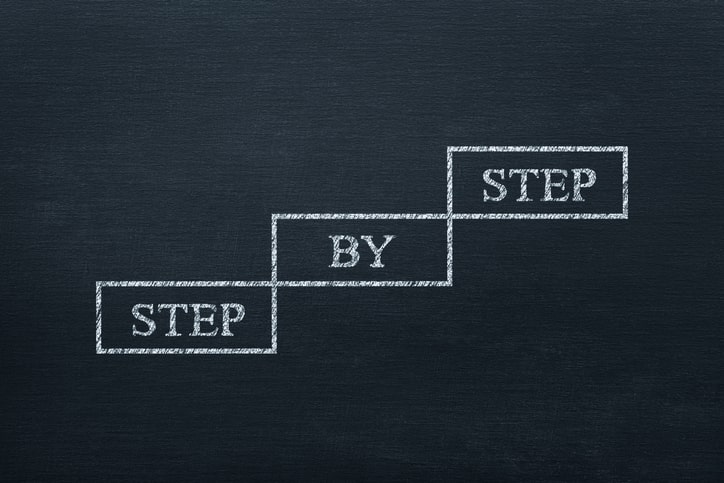“A journey of a thousand miles begins with a single step.” – Lao Tzu
“Simple can be harder than complex: You have to work hard to get your thinking clean to make it simple. But it’s worth it in the end because once you get there, you can move mountains.” – Oliver Wendell Holmes Sr.
Profound change starts with small steps aligned with your goals and objectives. Whether you’re trying to lose weight, get a new job, let go of ruminating thoughts, or just be okay with who you are, your mindset and the actions—you take or don’t—are two critical factors that will determine your success in making a shift.
Ultimately, you must be ready, willing, and able to change, as well as slow down to simplify. Even if your brain loves creating complexity and urgency, not everything needs to be planned and achieved simultaneously.
Instead, organizing your top priorities into bite-size tasks and doing one thing at a time will make your goals more manageable and attainable and allow you the flexibility to pivot.
Your desire, vision, and actions must be stronger than your resistance.
If you’re stuck in your current state, YOU may be holding yourself back. The Beckhard-Harris Change Model’s formula for success indicates that your desire, vision, and first steps must be present to overcome resistance.
In other words, you must be dissatisfied with your current status and have a strong vision for where you want to go, and your activities need to support the direction you want to head. Furthermore, you may need to stretch out of your comfort zone and tap into emotional intelligence (EQ) skills you’re not using in order to progress.
Remember that you are NOT defined or locked into anything based on your personality type, style, or conditioned behaviors. However, acknowledging and accepting your strengths, weaknesses, innate tendencies, survival strategies, and preferences boosts your self-awareness, providing key data points that are instrumental for change.
Reclaim your personal power using structured “micro- & mini-” techniques.
Self-leadership is about getting to know yourself better and applying that insight to how you act, think, and feel to enable positive momentum. There is no right or wrong to learning new skills or transforming habits. It’s about discovering and implementing a structure that works best for you at a deliberate and repeatable pace.
Start small and seek support if you’re uncertain how to begin. Listening to a podcast, watching a tutorial, signing up for a class, joining a specialized organization, working with a friend, or hiring an experienced coach are just a few ways to hold yourself accountable.
Here are some focus areas and exercises for personal and professional growth and advancement:
Become a more effective influencer.
To influence, you need to know your stakeholders, how they speak, and what’s important to them. In other words, you must remain agile and quickly adapt what you’re saying for it to resonate with them so they buy into whatever you are sharing or asking. Furthermore, you must articulate your message in a concise, compelling, and credible manner. Also, identifying when and how to assert yourself will be equally important if others are owning the conversation and direction. To do this effectively takes patience and practice. Some tools to boost your executive presence and stay true to your personal brand include the message triangle and EQ-i competency assessment.
Navigate uncertainty and change.
Understanding your system, staying balanced, and being able to handle the ups and downs are critical when your environment is unstable. Remaining optimistic when faced with doubt is possible. Shifting your mindset to focus on what’s in your control and being situationally aware enables you to process negative energy and decipher between rational and irrational behaviors, thoughts, and emotions. Assessing what your system needs moment-by-moment allows you to give it what it needs so you can operate at your highest expression. The Enneagram highlights your core motivation and how you act, think, and feel and offers complementing strategies to offset stress and take care of your mental and physical health.
Bolster self-confidence and resilience.
Insights from the EQ-i and Enneagram assessments offer ways to strengthen your self-confidence, resiliency, and bounce-back rate. Also key when challenged is reminding yourself that there can be more than one “right way.” Being open to other’s perspectives, experimenting with compromise, and meeting people where they are at allows you to see differently and connect with the underlying emotions that may be triggering you. Some tangible methods to reinforce your strengths, passion, and workflow include a SWOT Analysis and the Sparketype® assessment. Additionally, “Drawing your Gremlin Out” can help you get to know and befriend any critical or judging parts of you that are impacting your self-worth.
Embody a more balanced approach in your daily routine.
You have three intelligence centers defined by the Enneagram—thinking, action, and feeling—aligned with your head, body, and heart. You have your go-to approach with one center potentially overworked, while another may be underworked. With awareness of your innate “default settings,” you can implement new habits and skills to create more harmony between your inner and outer worlds. The “MBTI® Zig-Zag Process,” where you tap into your four mental functions, and “Best-case and Worst-Case Scenario” planning are methods to elevate your decision-making and problem-solving capabilities.
Let go of what’s holding you back.
Your habitual belief patterns and instinctual behaviors influence what you see and experience. Your conscious and unconscious filters—“cognitive distortions”—can generalize, block out, delete, and twist information. “Letting go” is about discovering what’s holding you back and freeing yourself from the burdens you’re carrying, like ruminating thoughts, triggered emotions, or survival behaviors. To do this exercise, you don’t need to know HOW. You just need to be WILLING to say goodbye to what’s troubling, which includes accepting all parts of yourself, reclaiming your authority, and using that energy for something you deem important.
Organize, prioritize, and set boundaries.
When you feel overwhelmed or have a never-ending to-do list, it’s a sign to clear out your brain clutter. The “Stop, Start, Continue,” widely used in change management for transition planning, is a great tool. The process can be liberating as you reprioritize necessities and what you value most. Also, learning to “say no kindly”—at least for now—is paramount. This exercise helps you understand what is zapping your energy and asks you to take back control of your schedule. Because when you say “Yes” to one thing, you’re saying “No” to another. And, whether you state “No” more often or express “Yes” on your terms, you also release yourself from people-pleasing.
Who you surround yourself with matters.
Change can be less daunting—albeit even fun—when someone holds you accountable, is honest, and is rooting for your success. So don’t go it alone. Instead, grab a friend or trusted colleague to learn, support, and inspire each other. Check out my “Micro & Mini Service Offerings” and request one session to motivate you, such as creating a personalized roadmap that makes sense for you. Sign up solo or with another person or group to work on a specific exercise or activity and split the costs!
Deepen your perspective to activate your best.
As a lifelong student, certified professional coach, and consultant, activating the best in others through self-leadership, interpersonal relations, and team dynamics are passions of mine. My approach is personalized and customized, tapping into various assessments, disciplines, modalities, and techniques.

